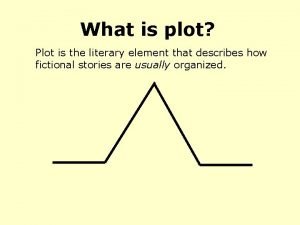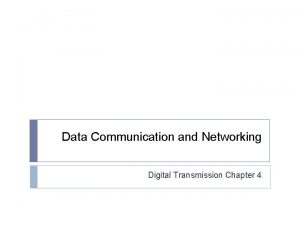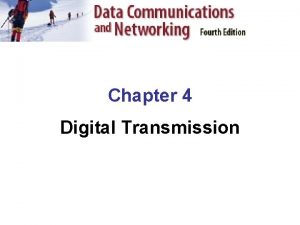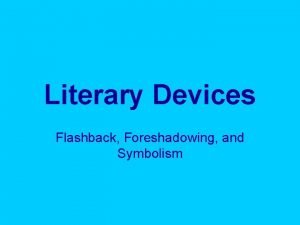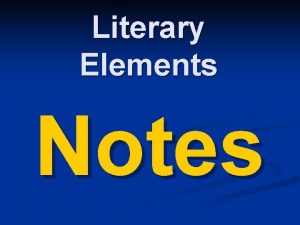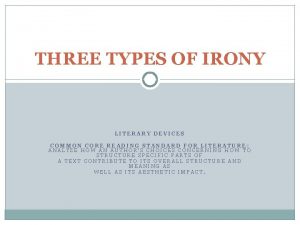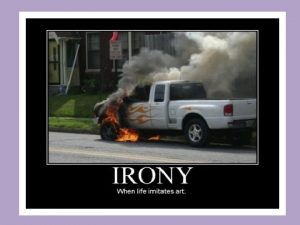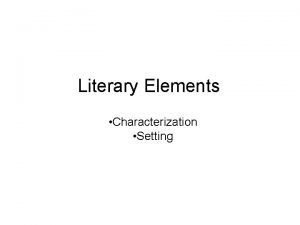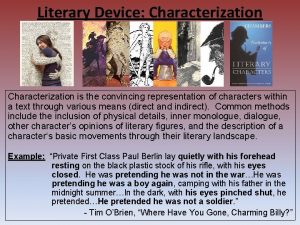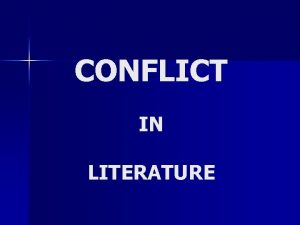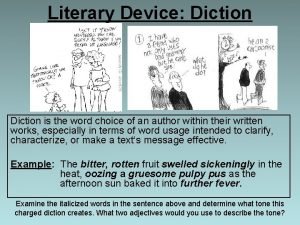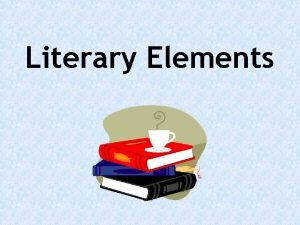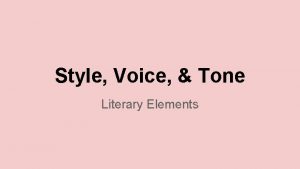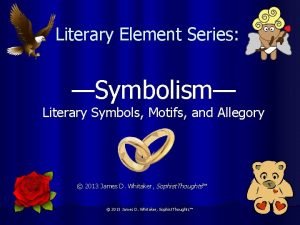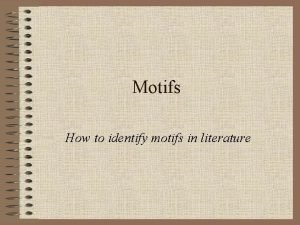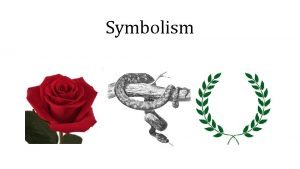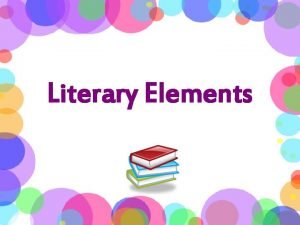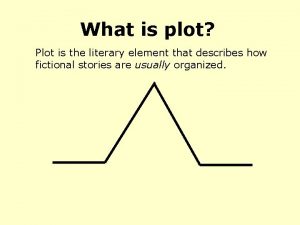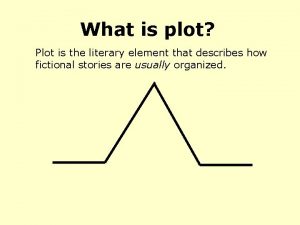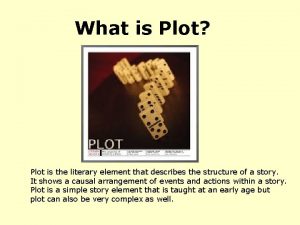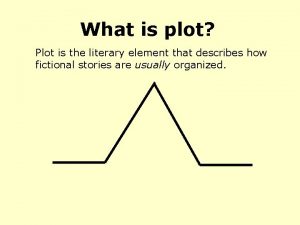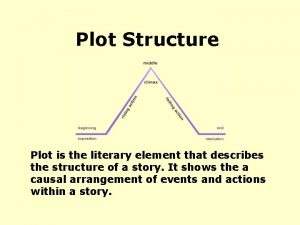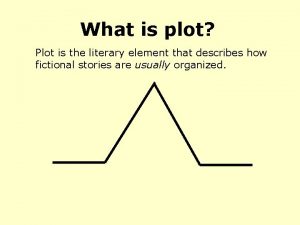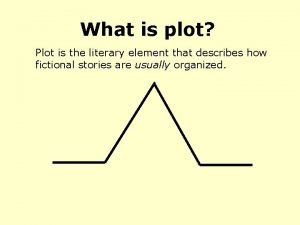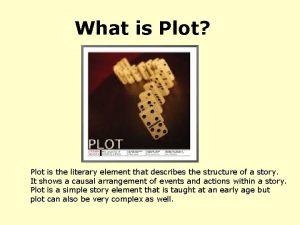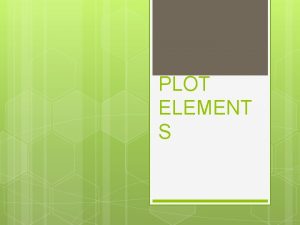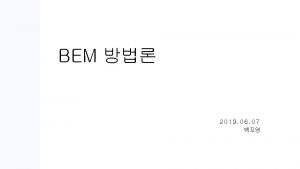What is Plot Plot is the literary element






















- Slides: 22

What is Plot? Plot is the literary element that describes the structure of a story. It shows a causal arrangement of events and actions within a story. Plot is a simple story element that is taught at an early age but plot can also be very complex as well.

Plot versus action For the purposes of this class, the events that happen in a novel will be referred to the action of the novel. The term plot will be used for the way an author sequences and paces the events. This helps shape our response and interpretation of the literary work.

What are Plot Components? Climax: the turning point, the most intense moment—either mentally or in action Rising Action: the series of conflicts and crisis in the story that lead to the climax Exposition: the start of the story, the situation before the action starts Falling Action: all of the action which follows the climax Resolution: the conclusion, the tying together of all of the threads Conflict: Conflict is the dramatic struggle between two forces in a story. Without conflict, there is no plot.

What is Plot Structure? Freytag’s Pyramid is often modified so that it extends slightly before and after the primary rising and falling action. You might think of this part of the chart as similar to the warm-up and cooldown for the story.

Time Manipulators Flashbacks A literary or cinematic device in which an earlier event is inserted into the normal chronological order of a narrative. Purpose: It is a technique that bridges time, place and action to reveal information about the character, or move the story forward. Flash-forward A literary or cinematic device in which the chronological sequence of events is interrupted by the interjection of a future event. Purpose: To show the consequences of events and actions on characters within a story without having to follow the impact of those events in normal narrative setting. To give a reader a glimpse of a possible future for the characters within a story. It could occur anywhere within a story, most often used to show “happy endings. ” Foreshadowing The presentation in a work of literature of hints and clues that tip the reader off as to what is to come later in the work. Purpose: To allow readers to come to certain conclusions (make things more believable) about characters and events within a story. Furthermore, it builds anxiety, and suspense throughout a storyline

What is a SUBPLOT? A subplot is a secondary story line that is not equal in strength and intensity to the main plot. It must be relevant to the main plot. Subplots may: create the feeling of more life-like main characters. reflect and enhance the action of the main plot. influence the direction of the main plot. provide comic relief.

Examples of subplots: 1. In the main plot of a romance, one or both of the main characters may resist commitment. Another couple in the story, perhaps friends, confidantes, or coworkers of the main characters, are also falling in love but having problems that show aspects of the love relationship the primary story line does not. The main characters, through their involvement with the other couple, may learn from what they see and come to realize their own love for each other should not be denied. 2. In a story of conflict between a parent and a child, subplots involving a neighbor or friend's child may give some perspective on the main plot. Another subplot might be a visit from a grandparent that casts the parent back into the child role, an experience that helps that parent recall what his own childhood was like and results in a better understanding of his own child's behavior.

Types of Plots Dramatic or Progressive plot Episodic Plot In media res (in the middle of things) Flashback Plot Parallel Plot No-Linear Plot

Dramatic or Progressive Plot A Dramatic or Progressive Plot: This is a chronological structure which first establishes the setting and conflict, then follows the rising action through to a climax (the peak of the action and turning point), and concludes with a denouement (a wrapping up of loose ends). The majority of stories and novels that you read will follow this plot structure.

Episodic Plot An episodic plot is also a chronological ordered structure, but it consists of a series of loosely related incidents, usually about a chapter or two in length. These are commonly tied together by characters or a common theme. These are used when an author wants to explore the depth and personalities of a character or the local color of an area.

Interchapters Inter chapters are a type of episodic plot structure as well. Authors use this type of plot structure when they want to provide a relevant social commentary or historical commentary to supplement the plot. A great example of this is Steinbeck’s The Grapes of Wrath.

In medias res is a Latin phrase meaning “in the middle of things. ” This is a very classic literary device. In this type of plot, the story begins after the action has already begun. The explanation of plot, characters and their roles, and the importance of setting are left to be discovered through flashback, dialogue, or a reverse chronology where the story if told backwards. Great examples: Homer’s The Odyssey, Dickens’ David Copperfield, Dante’s The Divine Comedy and recently in film, Raging Bull.

Flashback Plot This structure conveys information about events that occurred earlier. It permits authors to begin the story in the midst of the action but later fill in the background for full understanding of the present events. Flashbacks can occur more than once and in different parts of a story. To Kill a Mockingbird Catcher In The Rye

Parallel Plots: Plots in which each main character has a separate but related story line that merges in the end. Examples: Murderer and Detective Two family members with opposite goals or methods Rivals for a job Old enemies In the plot outline, main character 1 has the first section. The story then moves to main character 2 and alternates between the two characters until they come together in the end. Each main character and his or her plot receive equal time. Their sections are indicated by the series of parallel lines on the timelines below. Each segment of the story moves the plot forward in time. An occasional scene may overlap in time, but the general movement should be forward. Plot Diagram for Parallel Plot Structure ||||------|||||-------------||||--------------- Plot line for main character 1 -----||||-------------||||--------------||||------Plot line for main character 2

In the parallel plot, the characters might start out together and separate to follow their own paths, or they may not connect until the end. Their story lines are related and the climax occurs when the two (or more) come together at the end. Parallel plots may have more than two main characters. Just remember that each character's story gets equal time and to keep the plot moving forward. Once each main character is introduced, the writer then returns to the first character and repeats the cycle. Examples: School reunions, earthquakes and other natural disasters, terrorist attacks Plot Diagram for Parallel Plot Structure ||||------|||||-------------||||--------------- Main character 1 -----||||-------------||||--------------||||------- Main character 2 -----|||||--------------||||-------------||||-- Main character 3

Parallel Plots 1. In the plot outline, main character 1 has the first section. The story then moves to main character 2 and alternates between the two characters until they come together in the end. Each main character and his or her plot receive equal time. Each segment of the story moves the plot forward in time. An occasional scene may overlap in time, but the general movement should be forward. 2. In the parallel plot, the characters might start out together and separate to follow their own paths. Or they may not connect until the end. Their story lines are related and the climax occurs when the two come together at the end.

Parallel Plots In the movie Crash, there are many different characters and each of them has their own separate story. Throughout the movie, the story line of all characters is played out. You are thoroughly confused trying to keep up with each character and wondering how this all relates, and then, all of a sudden toward the end of the story, you start seeing how each of these characters come together at the end through one common factor. Soap opera on dramatic series on TV are often told in parallel form. Think about all the different characters, but somehow, many of them seem to have something in common with another character in the show. The events of their lives cross somewhere and at some time throughout the duration of the show, showing parallel plots.

Non Linear Plot Nonlinear narrative is a technique sometimes used in literature wherein events are portrayed out of chronological order. It is often used to mimic the structure and recall of human memory. Examples: • The Notebook • Forrest Gump • Dr. Who

These are some of the interesting ways graphics people are portraying the film Inception.



You now have the necessary information about PLOT (and the story-plot triangle and its components – exposition, rising action, climax, falling action, and resolution), about conflict, subplots, AND you have learned about the different types of plots. Now, you to turn to a partner and explain what each of these components are and where they occur in the stories we have read so far. I would also like for you to give an example – other than the ones I have used. We will do the same for Inception and Crash
 Is plot a literary element
Is plot a literary element Is plot a literary element
Is plot a literary element Is plot a literary element
Is plot a literary element Plot meaning literature
Plot meaning literature Difference between data element and signal element
Difference between data element and signal element Signal element vs data element
Signal element vs data element Literary elements
Literary elements Literary techniques and devices
Literary techniques and devices Literary element flashback
Literary element flashback Literary elements symbolism
Literary elements symbolism Irony poetic devices
Irony poetic devices Irony is a literary device
Irony is a literary device Literary element character
Literary element character Is characterization a literary element
Is characterization a literary element Literary element conflict
Literary element conflict Is diction a literary device
Is diction a literary device Cinderella internal conflict
Cinderella internal conflict Tone literary element
Tone literary element Symbol literary element
Symbol literary element Literary element symbol
Literary element symbol Motif literary device
Motif literary device Symbolism in literature
Symbolism in literature Literary elemnets
Literary elemnets
